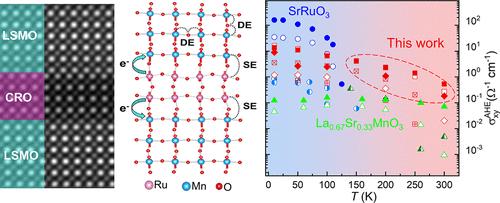Room-Temperature Ferromagnetism with Strong Spin–Orbit Coupling Achieved in CaRuO3 Interfacial Phase via Magnetic Proximity Effect
IF 16
1区 材料科学
Q1 CHEMISTRY, MULTIDISCIPLINARY
引用次数: 0
Abstract
Recently, theoretical and experimental research predicted that ferromagnets with strong spin–orbit coupling (SOC) could serve as spin sources with dramatically enhanced spin–orbit torque (SOT) efficiency due to the combination of spin Hall effect and anomalous Hall effect (AHE), presenting potential advantages over conventional nonmagnetic heavy metals. However, materials with a strong SOC and room-temperature ferromagnetism are rare. Here, we report on a ferromagnetic (FM) interfacial phase with Curie temperature exceeding 300 K in the heavy transition-metal oxide CaRuO3, in proximity to La0.67Sr0.33MnO3. Electron energy loss and polarized neutron reflectometry spectra reveal the strong charge transfer from Ru to Mn at the interface, triggering antiferromagnetic exchange interactions between interfacial Ru/Mn ions and thus transferring magnetic order from La0.67Sr0.33MnO3 to CaRuO3. An obvious advantage of such interfacial phase is the enhanced anomalous Hall effect at temperatures from 150 to 300 K. Compared to the most promising room-temperature ferromagnetic oxide La0.67Sr0.33MnO3, the anomalous Hall conductivity σxyAHE (or anomalous Hall angle θH) of CaRuO3/La0.67Sr0.33MnO3 superlattices is increased by 30 (or 31) times at 150 K and 10 (or 3) times at 300 K. This work demonstrates a special approach for inducing ferromagnetism in heavy transition-metal oxides with strong SOC, offering promising prospects for all-oxide-based spintronic applications.

通过磁接近效应在 CaRuO3 面间相中实现具有强自旋轨道耦合的室温铁磁性
最近,理论和实验研究预测,由于自旋霍尔效应和反常霍尔效应(AHE)的结合,具有强自旋轨道耦合(SOC)的铁磁体可以作为自旋源,显著提高自旋轨道转矩(SOT)的效率,与传统的非磁性重金属相比具有潜在的优势。然而,具有强 SOC 和室温铁磁性的材料并不多见。在此,我们报告了在重过渡金属氧化物 CaRuO3 中与 La0.67Sr0.33MnO3 相似的居里温度超过 300 K 的铁磁 (FM) 界面相。电子能量损失和偏振中子反射光谱揭示了界面上从 Ru 到 Mn 的强电荷转移,引发了界面 Ru/Mn 离子之间的反铁磁交换相互作用,从而将磁序从 La0.67Sr0.33MnO3 转移到 CaRuO3。与最有前途的室温铁磁性氧化物 La0.67Sr0.33MnO3 相比,CaRuO3/La0.67Sr0.33MnO3 的反常霍尔电导率 σxyAHE(或反常霍尔角 θH)在 150 至 300 K 的温度范围内得到增强。这项工作展示了一种在具有强 SOC 的重过渡金属氧化物中诱导铁磁性的特殊方法,为基于全氧化物的自旋电子应用提供了广阔的前景。
本文章由计算机程序翻译,如有差异,请以英文原文为准。
求助全文
约1分钟内获得全文
求助全文
来源期刊

ACS Nano
工程技术-材料科学:综合
CiteScore
26.00
自引率
4.10%
发文量
1627
审稿时长
1.7 months
期刊介绍:
ACS Nano, published monthly, serves as an international forum for comprehensive articles on nanoscience and nanotechnology research at the intersections of chemistry, biology, materials science, physics, and engineering. The journal fosters communication among scientists in these communities, facilitating collaboration, new research opportunities, and advancements through discoveries. ACS Nano covers synthesis, assembly, characterization, theory, and simulation of nanostructures, nanobiotechnology, nanofabrication, methods and tools for nanoscience and nanotechnology, and self- and directed-assembly. Alongside original research articles, it offers thorough reviews, perspectives on cutting-edge research, and discussions envisioning the future of nanoscience and nanotechnology.
 求助内容:
求助内容: 应助结果提醒方式:
应助结果提醒方式:


